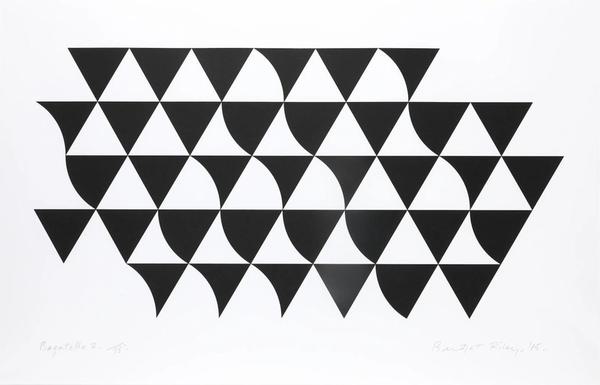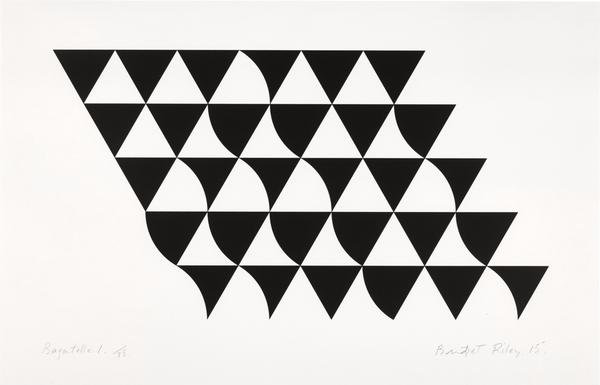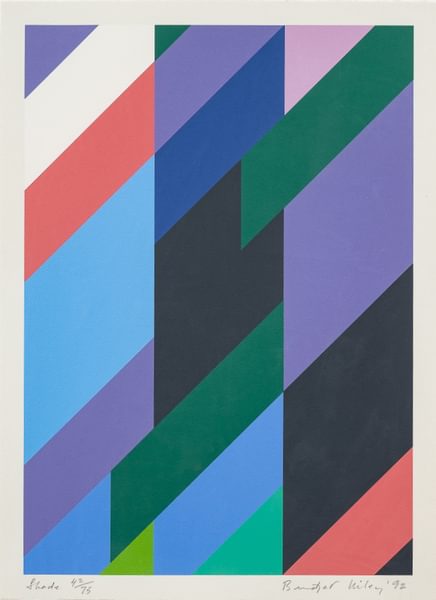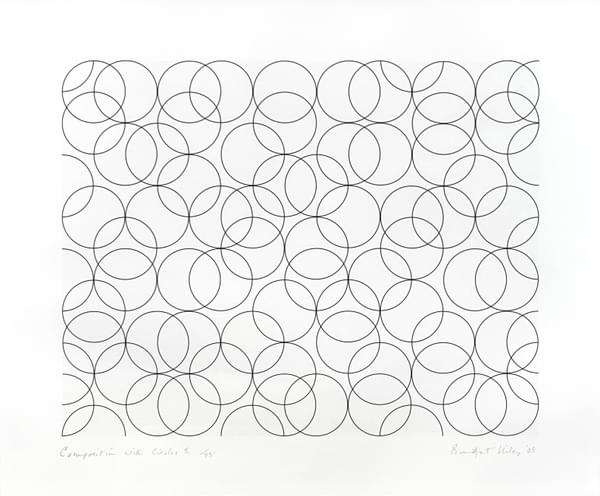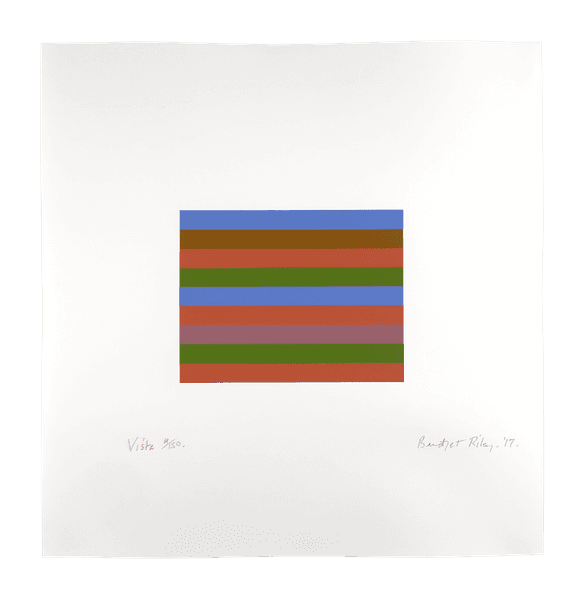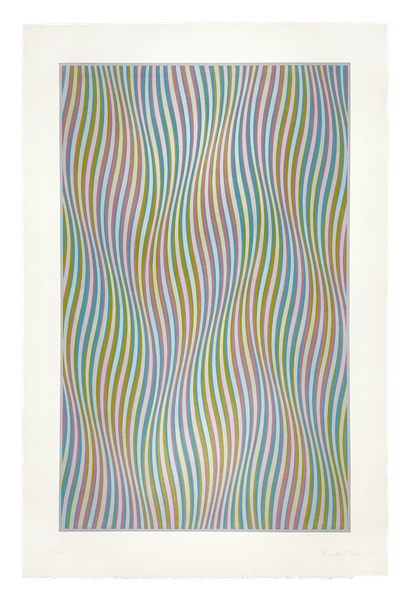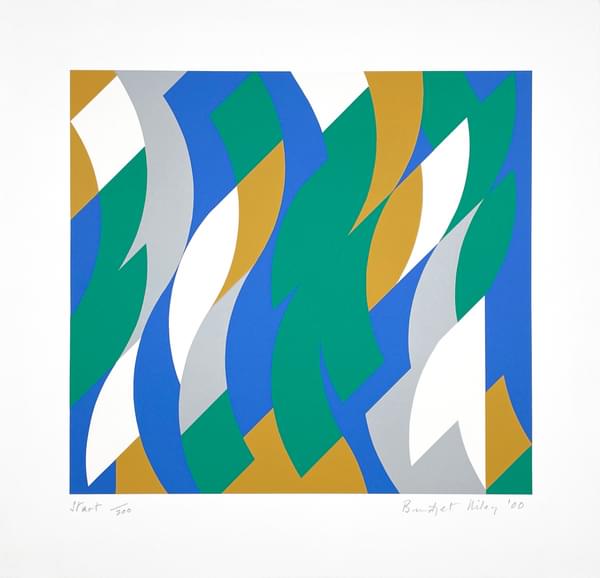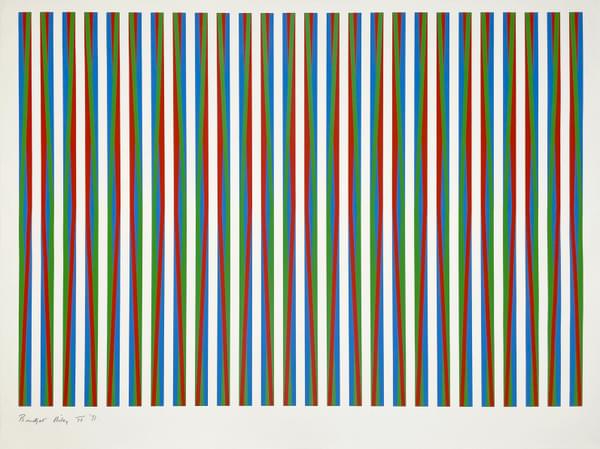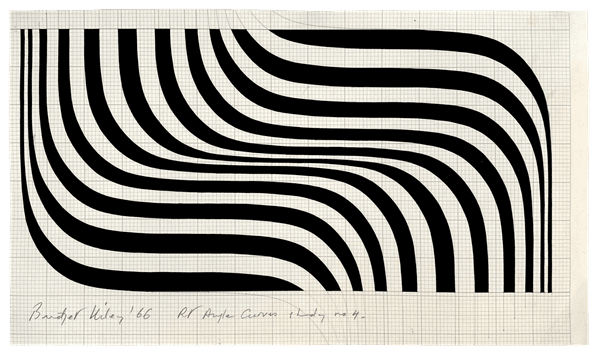Untitled [Fragment 1]
"..Riley...initiated the extraordinary series of seven prints called Fragments, exhibited at Robert Fraser Gallery. Her catalogue note sums up the role of screen printing in her work at that time, a position which, almost forty years on, remains unchanged. 'During the preparatory work for a painting, I may make images which are tangential to the problems posed by the particular painting. Some of these images I return to and develop later, others remain as fragments of a theme. These prints are a selection of such fragments in my folios and cover a period from 1962-1965.' While from the first Riley knew that any prints she made would be essentially separate from the main thrust of her work, she was also quick to recognise that they could occasionally allow her to make work in a way that could be achieved by no other means. In the case of Fragments, she used making screen prints as a way of experimenting with an entirely new material, Plexiglas, a form of transparent plastic.
Artists in the early Sixties had left post-war austerity behind them and were inspired by the sense that they were creating a brave new world. 'We were excited about trying new materials - we all wanted the new!' Riley explains. Plexiglas, clean, clear, fresh and synthetic, symbolised this sense of a new beginning: anything was possible. But not at Kelpra. The studio, despite its considerable technical expertise, did not know how to handle the unfamilar material. The work had to be sent out to a commercial sign printer experienced in working with plastic, for the printing was to be done directly on to the back of the plastic sheet. The black figure was printed first, the white ground added afterwards: the completed image was immediately visible through the transparent material. There was no need for the prints to be covered in glass, which had attracted Riley to experiment with the material in the first place. Her intuition proved sound: the transparency of the Plexiglas seems to give the prints a new sort of life, a perfect marriage of image and support."
Lynn MacRitchie, 'Fragments of a Theme', from Bridget Riley Complete Prints 1962-2005, Karsten Schubert, Ridinghouse Editions, London, 2005.
Fragment 1 seems to have emerged from an earlier painting, ‘Off’ (illustrated right) painted in 1963, which resembles the right-hand side of the print. Maurice de Sausmarez, in his book Bridget Riley, 1970, noted a ‘Classic example of energy produced by the simplest means.’ Ten black bands set out at top and bottom with a regular relationship in each case, are joined to a radically compressed diagonal directional line, in which the relationship changes to a sequence of progressively increased measurements.
Other examples of this work belong to the permanent collections of the Tate Gallery, MoMA, and the Government Art Collection (presently hanging in the British Embassy, Santiago, Chile).
Untitled [Fragment 1]
- Artist
- Bridget Riley (b.1931)
- Title
- Untitled [Fragment 1]
- Medium
- Screenprint on plexiglas
- Date
- 1965
- Size
- 26½ x 33 in. : 67.3 x 83.8 cm.
- Edition
- From the edition of 75, signed and dated by the artist (in reverse from back)
- Printer
- Printed by a commercial signmaker under license from Kelpra Studios, London
- Publisher
- Robert Fraser Gallery, London
- Provenance
- Richard Feigen Gallery, New York
Richard Saltoun, London - Literature
- "Bridget Riley - The Complete Prints 1962-2020", The Bridget Riley Art Foundation, Thames & Hudson, London, 2020, no. BRS 6A, pp.60-61 (illus.)
Schubert 5a
Arts Council, 1980, no.1 - Exhibited
- Robert Fraser, London, 1965, no.1
Documenta 4, Kassel, 1968, no.1
Arts Council 1970-71, included at the following venues: London, no.222, Hannover, Bern and Düsseldorf, no.152, Turin, no.150
Tate Gallery, London, 1973
Arts Council, London, 1973-74, no. 6
Arts Council, London, 1980-84, no.1
Queensland Art Gallery, Brisbane, 1985, no.3
Arts Council, London, 2001-03
British Council, London, 2004-05
Museum of Modern Art, New York, 2006-08
Art Gallery of Western Australia, Perth, 2011
Städtische Galerie, Villingen-Schwenningen, 2013
"Seurat to Riley", Compton Verney, 2017-18
Tate Liverpool, 2018-2020
National Galleries of Scotland, Edinburgh, 2019
Museum in Kulturspeicher Würzburg, 2019
Hayward Gallery, London, 2019-20 - Illustration notes
- The second illustration (right) depicts Bridget Riley's 'Off', 1963, a related work in the evolution of Fragment 1
- Reference
- A18-38
- Status
- No Longer Available
Available Artists
- Ancart Harold
- Andre Carl
- Avery Milton
- Baldessari John
- Barnes Ernie
- Brice Lisa
- Castellani Enrico
- Crawford Brett
- Dadamaino
- Dávila Jose
- de Tollenaere Saskia
- Downing Thomas
- Dyson Julian
- Elsner Slawomir
- Freud Lucian
- Gadsby Eric
- Gander Ryan
- Guston Philip
- Haring Keith
- Held Al
- Hockney David
- Katz Alex
- Kentridge William
- Knifer Julije
- Le Parc Julio
- Leciejewski Edgar
- Léger Fernand
- Levine Chris
- LeWitt Sol
- Marchéllo
- Mavignier Almir da Silva
- Miller Harland
- Modé João
- Morellet François
- Nadelman Elie
- Nesbitt Lowell Blair
- O'Donoghue Hughie
- Odita Odili Donald
- Perry Grayson
- Picasso Pablo
- Pickstone Sarah
- Prehistoric Objects
- Quinn Marc
- Riley Bridget
- Ruscha Ed
- Serra Richard
- Shrigley David
- Smith Anj
- Smith Richard
- Soto Jesús Rafael
- Soulages Pierre
- Spencer Stanley
- Taller Popular de Serigrafía
- The Connor Brothers
- Turk Gavin
- Vasarely Victor
- Wood Jonas
![Bridget Riley Untitled [Fragment 1] black and white screenprint on plexiglas for sale](https://images.archeus.com/production/A18-38-Riley-Fragment-1-black-and-white-screenprint-on-plexiglas.jpg?w=1200&h=1200&q=82&auto=format&fit=clip&dm=1683055313&s=7feae521f559a215f392711ee8d9b012)
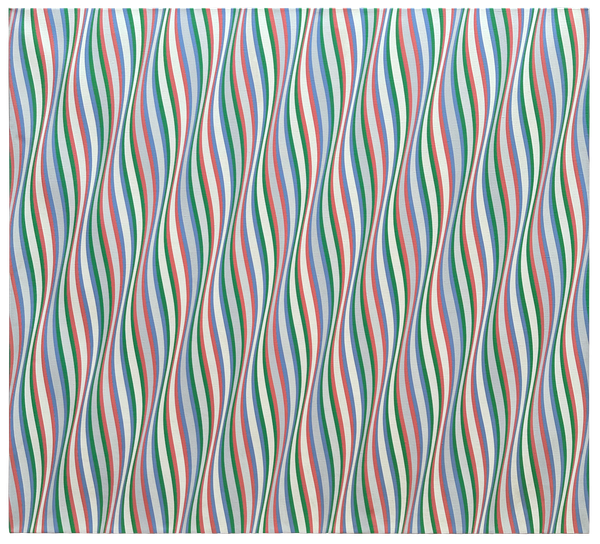
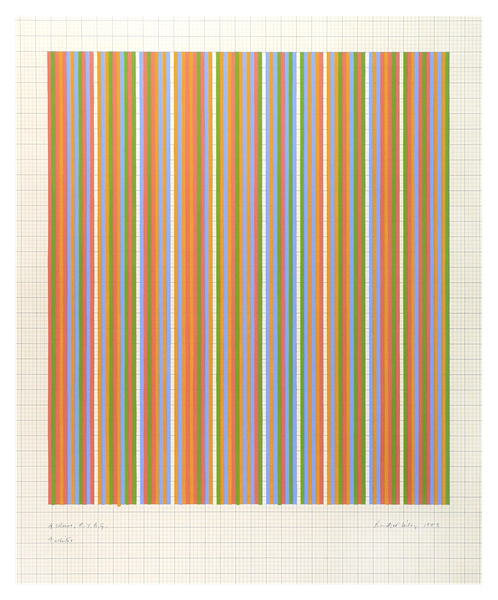
![Untitled [Winged Curve] - Bridget Riley](https://images.archeus.com/production/A22-38-RILEY-Winged-Curve-sheet-unnumbered.png?w=600&h=600&q=60&auto=format&fit=clip&dm=1683055660&s=d96bb1b5e3cf186dd8f0b0cbc10bd611)
